View in other NatureServe Network Field Guides
NatureServe
Montana
Utah
Wyoming
Idaho
Wisconsin
British Columbia
South Carolina
Yukon
California
New York
Scalepod - Idahoa scapigera
State Rank Reason (see State Rank above)
Rare and peripheral in Montana. Currently known from approximately a half-dozen sites in western Montana, mostly along the lower slopes of the Bitterroot Mountains. Populations are highly susceptible to negative impacts from invasive weeds, primarily spotted knapweed and cheatgrass. Data on population trends are lacking, though levels likely fluctuate widely from year to year.
- Details on Status Ranking and Review
Population Size
Score2-3 - Very Small to Small: Population size is imprecisely known but is believed to be <10,000 individuals.
Range Extent
Score2 - Regional or State Endemic or Small Montana Range: Generally restricted to an area <100,000 sq. miles (equivalent to 2/3 the size of Montana or less) or Montana contributes 50% or more of the species’ range or populations OR limited to 2-3 Sub-basins in Montana.
CommentPeripheral in western Montana.
Area of Occupancy
Score2 - Low: Generally occurring in 4-10 Subwatersheds (6th Code HUC’s).
Environmental Specificity
Score1-2 - Moderate to High.
Trends
ScoreNA - Rank factor not assessed.
CommentTrends are unknown, though may be declining due to impacts to habitat quality, particularly from invasive species.
Threats
Score2-3 - High to Very High.
CommentInvasive species such as cheatgrass and spotted knapweed are a primary threat.
Intrinsic Vulnerability
Score1-2 - Moderate to High Vulnerability.
Raw Conservation Status Score
Score
10 to 14 total points scored out of a possible 16 (Rarity factors and threats only).
General Description
Scalepod is a small, glabrous annual with many leafless stems that are up to 10 cm high. The numerous basal leaves have a long, slender petiole and narrowly elliptic blades that are 5-15 mm long with entire margins or two shallow lobes near the base. Each stem bears a single white flower at the tip. Each flower has 4 red to purple, separate sepals that are ca. 2 mm long, 4 separate petals of the same length, and 4 long and 2 short stamens. The flowers quickly form flattened, nearly circular fruits that are 6-12 mm in diameter with 6-12 wing-margined seeds inside.
Phenology
Flowering in March-April.
Diagnostic Characteristics
Species of Draba and Subularia have more than one flower (or fruit) per stem.
Species Range
Montana Range
Range Descriptions
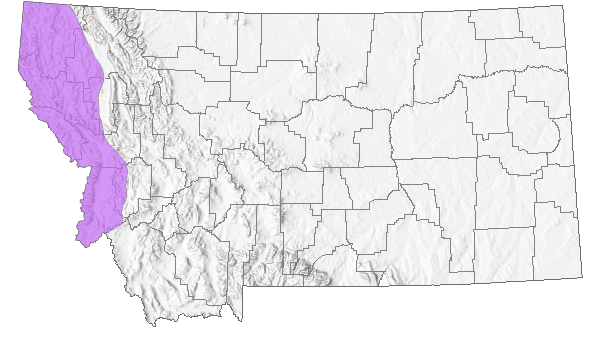
 Native
Native
Range Comments
WA to CA, east to ID and w. MT. Peripheral.
Observations in Montana Natural Heritage Program Database
Number of Observations: 34
(Click on the following maps and charts to see full sized version)
Map Help and Descriptions
Relative Density
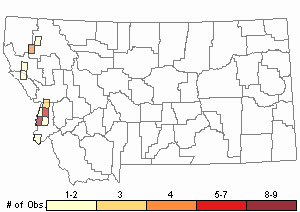
Recency
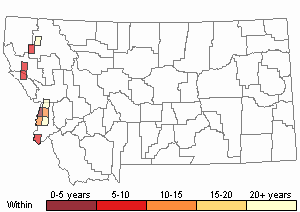
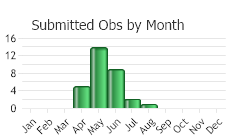
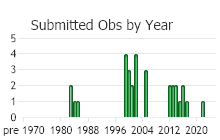
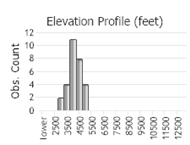 (Observations spanning multiple months or years are excluded from time charts)
(Observations spanning multiple months or years are excluded from time charts)
Habitat
Vernally moist, open soil on rock ledges in the lower montane zone.
Stewardship Responsibility
Threats or Limiting Factors
STATE THREAT SCORE REASON
Reported threats to Montana's populations of Scalepod include disturbances with potential to destroy plants or lead to indirect negative impacts, especially those that introduce or aggravate existing non-native plant populations (MTNHP Threat Assessment 2021). Recreation occurring at populations or in the vicinity can inflict injury or mortality to plants or populations. One population is at a popular rock-climbing site, and others are located where off-highway vehicle (OHV) use is unregulated. Competition from Spotted Knapweed (Centaurea stoebe), and Cheatgrass (Bromus tectorum) occur at some populations, and are likely to have direct negative impacts to Scalepod populations.
References
- Literature Cited AboveLegend:
 View Online Publication
View Online Publication MTNHP Threat Assessment. 2021. State Threat Score Assignment and Assessment of Reported Threats from 2006 to 2021 for State-listed Vascular Plants. Botany Program, Montana Natural Heritage Program, Helena, Montana.
MTNHP Threat Assessment. 2021. State Threat Score Assignment and Assessment of Reported Threats from 2006 to 2021 for State-listed Vascular Plants. Botany Program, Montana Natural Heritage Program, Helena, Montana.
- Additional ReferencesLegend:
 View Online Publication
View Online Publication
Do you know of a citation we're missing? Lesica, P., M.T. Lavin, and P.F. Stickney. 2012. Manual of Montana Vascular Plants. Fort Worth, TX: BRIT Press. viii + 771 p.
Lesica, P., M.T. Lavin, and P.F. Stickney. 2012. Manual of Montana Vascular Plants. Fort Worth, TX: BRIT Press. viii + 771 p. Lesica, P., M.T. Lavin, and P.F. Stickney. 2022. Manual of Montana Vascular Plants, Second Edition. Fort Worth, TX: BRIT Press. viii + 779 p.
Lesica, P., M.T. Lavin, and P.F. Stickney. 2022. Manual of Montana Vascular Plants, Second Edition. Fort Worth, TX: BRIT Press. viii + 779 p. Quire, R.L. 2013. The sagebrush steppe of Montana and southeastern Idaho shows evidence of high native plant diversity, stability, and resistance to the detrimental effects of nonnative plant species. M.Sc. Thesis. Bozeman, MT: Montana State University. 124 p.
Quire, R.L. 2013. The sagebrush steppe of Montana and southeastern Idaho shows evidence of high native plant diversity, stability, and resistance to the detrimental effects of nonnative plant species. M.Sc. Thesis. Bozeman, MT: Montana State University. 124 p.
- Web Search Engines for Articles on "Scalepod"





